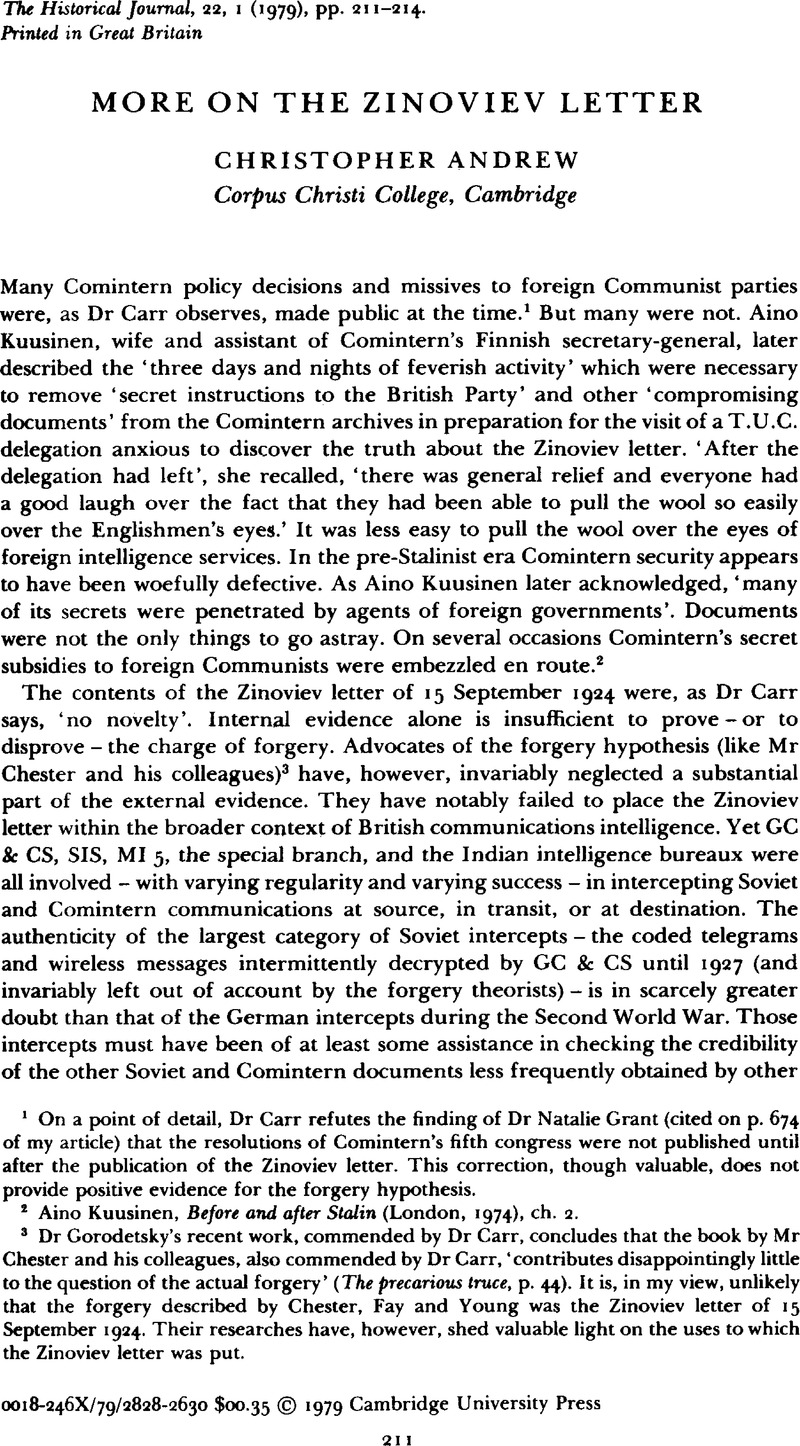Article contents
More on the Zinoviev Letter
Published online by Cambridge University Press: 11 February 2009
Abstract

- Type
- Communications
- Information
- Copyright
- Copyright © Cambridge University Press 1979
References
1 On a point of detail, Dr Carr refutes the finding of Dr Natalie Grant (cited on p. 674 of my article) that the resolutions of Comintern's fifth congress were not published until after the publication of the Zinoviev letter. This correction, though valuable, does not provide positive evidence for the forgery hypothesis.
2 Kuusinen, Aino, Before and after Stalin London, 1974), ch. 2Google Scholar.
3 Dr Gorodetsky's recent work, commended by Dr Carr, concludes that the book by Mr Chester and his colleagues, also commended by Dr Carr, ‘contributes disappointingly little to the question of the actual forgery’ (The precarious truce, p. 44). It is, in my view, unlikely that the forgery described by Chester, Fay and Young was the Zinoviev letter of 15 September 1924. Their researches have, however, shed valuable light on the uses to which the Zinoviev letter was put.
4 Andrew ‘The British secret service and Anglo-Soviet relations’, part I, pp. 677, 697–8. SirPetrie, David, Communism in India 1924–27, 2nd edn, ed. Saha, M. (Calcutta, 1972), pp. 77–82Google Scholar. DrCarr, himself uses Petrie's intelligence summaries as source material on a number of occasions in the final volume of his masterly History of Soviet Russia: Foundations of a Planned Economy 1926–1929, III, part in (London, 1978), 692, 694, 912, 914–17, 920, 922–3, 938–41, 947, 952CrossRefGoogle Scholar.
5 This is a failing of Dr Gorodetsky's valuable study of Anglo-Soviet relations, The precarious truce. Although he refers to two other ‘Zinoviev letters’ of 1924, he also fails to consider the broader context of British communications intelligence.
6 Crowe to MacDonald, 26 Oct. 1924, P.R.O., F.O. 371/10478.
7 For an analysis of some of this evidence see Trevor Barnes, ‘The first Labour government and the special branch’, forthcoming in The Historical Journal.
8 Sinclair to Crowe, 6 Nov. 1924, F.O. 371/10479. Kuusinen, Before and after Stalin, pp. 50–1.
9 Sinclair to Crowe, 6 Nov. 1924, F.O. 371–10479. The Foreign Once thus did have reason to believe in the existence of an original Russian draft of the Zinoviev letter, although the version sent to the British Communist party was in English. This does not, of course, prove that the Harvard text was that original draft.
10 For evidence that GC & CS was able, at least intermittently, to decrypt Russian telegrams as late as 1927 see part 2 of my article ‘The British secret service and Anglo-Soviet relations in the 1920s’, forthcoming in The Historical Journal during 1979.
11 MacDonald, however, had access only to the intelligence reports on how the Zinoviev letter had been obtained and to the ‘corroborative’ reports of the MI 5 informer. He was unable to examine even this evidence until after the October 1924 election. A committee of the defeated Labour cabinet then found it impossible to reach a decision on the letter's authenticity in the ‘short time available’ before the government resigned. The second and third ‘corroborative proofs’ were not obtained until after MacDonald's resignation. This is one of several explanations for the ‘discrepancies’ mentioned by Dr Carr between MacDonald's statements to the Commons and those of Conservative ministers.
12 Roskill, Stephen, Hankey, man of secrets (London, 1970–4), II, 385; III, 446–7Google Scholar.
13 It is necessary in that case to assume much greater incompetence than in 1921, for the 1921 forgeries had been detected.
- 1
- Cited by


